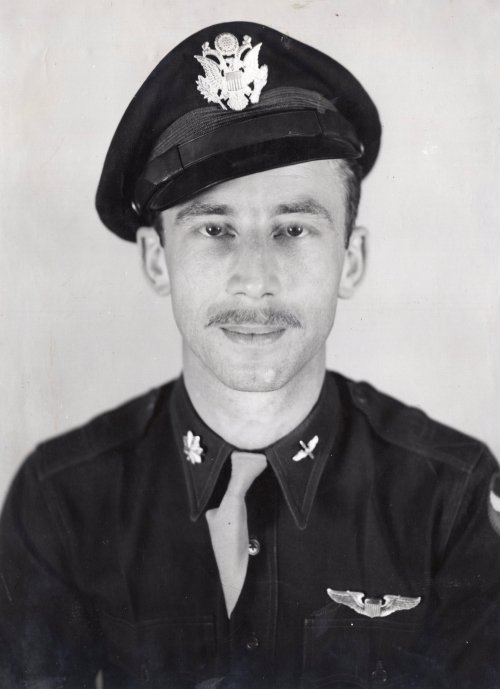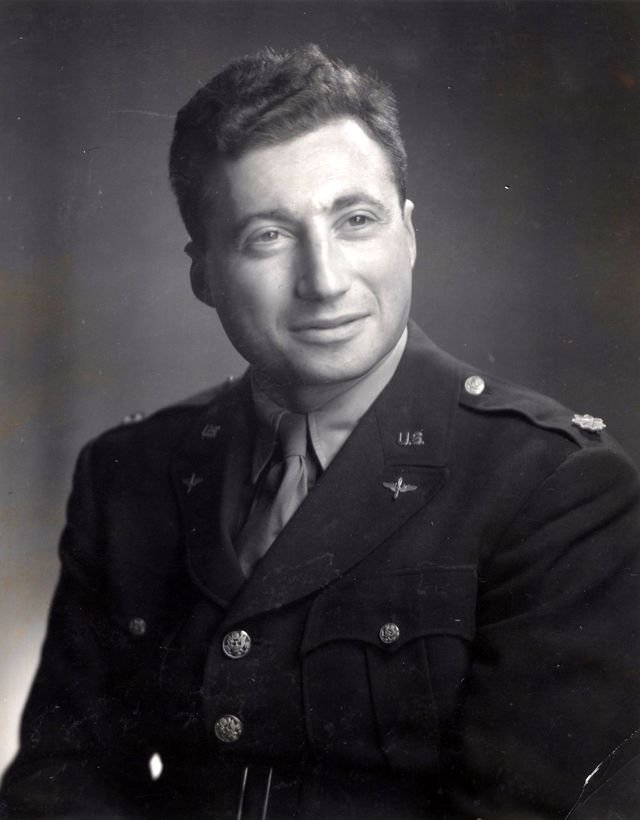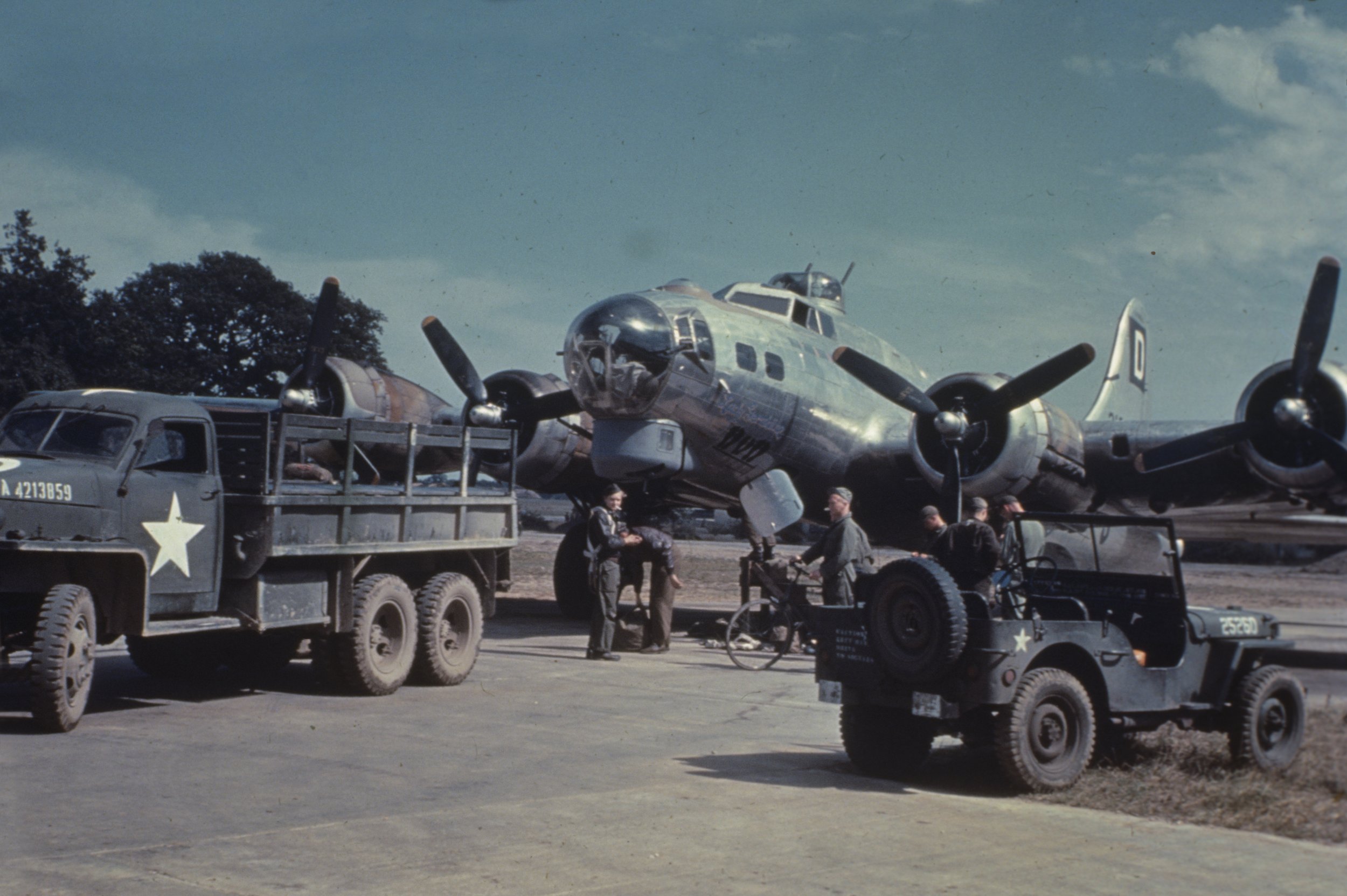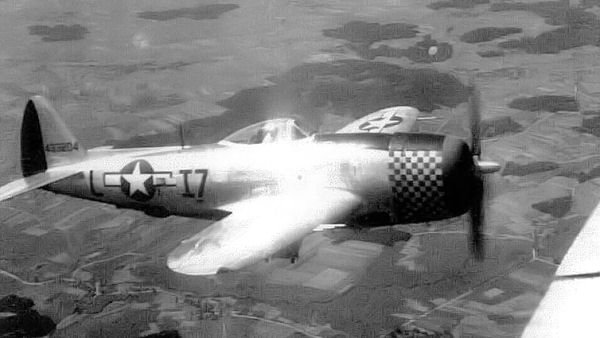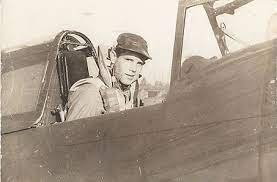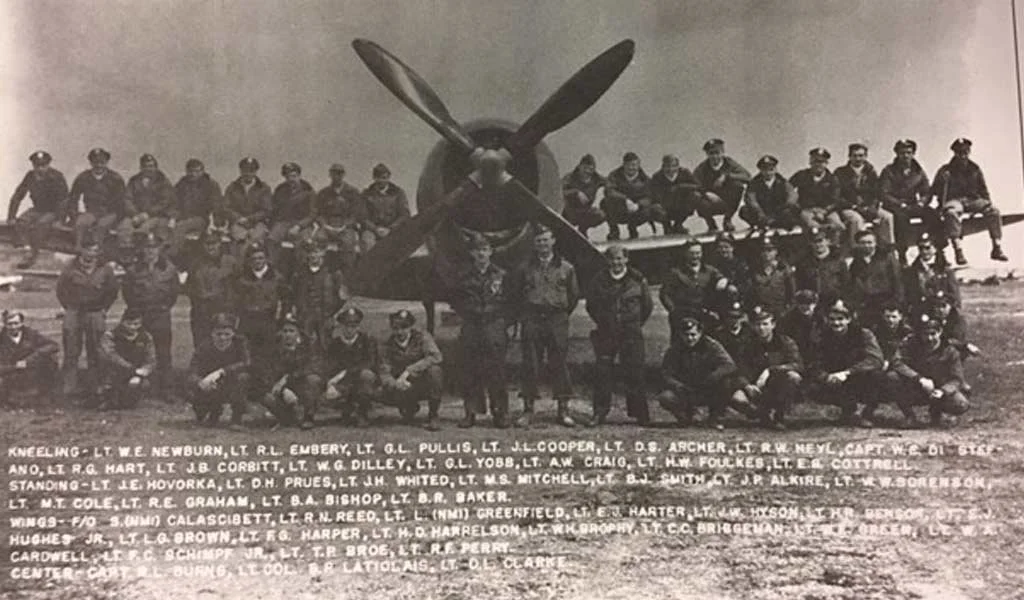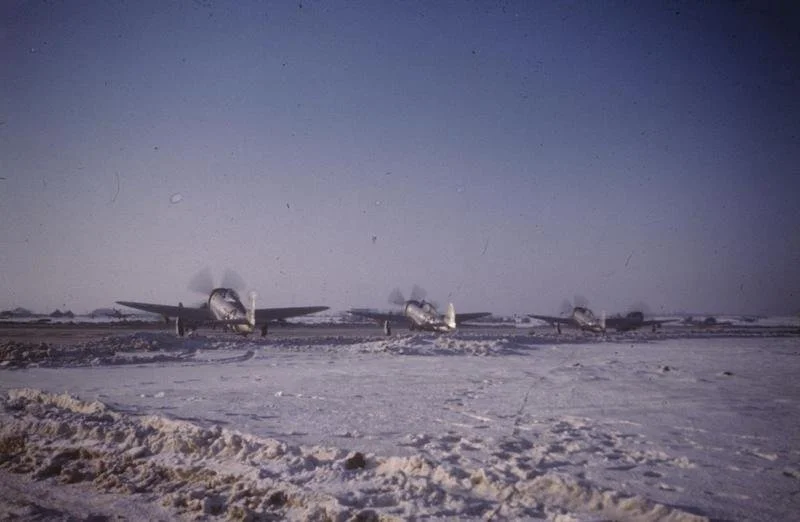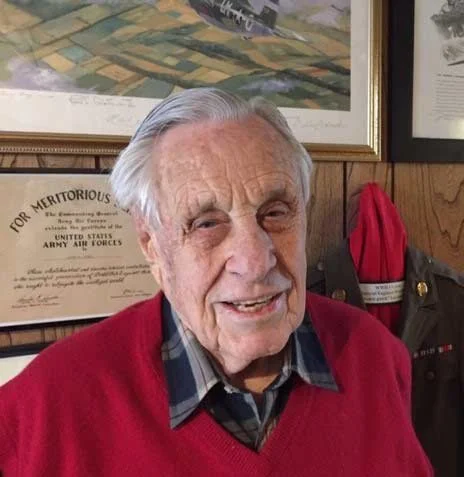Masters of the Air: The Bremen Raid
/B-17s of the 388th bomb group over Bremen on october 8, 1943. photo: item fre 1498, american air museum.
In Episode 4 of Apple TV+ series “Masters of the Air”, a raid is discussed by several characters but not shown on screen. The mission to Bremen on October 8th, 1943 was a costly one that saw one of the main figures in the 100th Bombardment Group, Gale “Buck” Cleven shot down and captured. Over 80 years later, one of the last surviving pilots from the 100th BG, John “Lucky” Luckadoo recalls the mission.
By Seth Marshall
In the late summer and fall of 1943, the United States Army Air Forces was in the process of mounting ever larger daylight raids targeting German war industry. Based upon interwar theory which suggested that bomber campaigns, known today as strategic bombing, had the capability to not only destroy an enemy nation’s capacity to wage war but also that country’s will to continue fighting, the USAAF’s 8th Air Force was tasked with carrying out this mission over European skies. While the British Royal Air Force conducted its bombing by night, the 8th Air Force insisted on a policy of daylight precision attacks, though the precision of these attacks was later found wanting. By the latter half of 1943, the 8th Air Force had begun to target the ball-bearing producing factories of Germany, believing that the destruction of these would cause a break down in German mechanization. In days preceding October 8th, 1943, USAAF planners began working on a maximum effort raid targeting Bremen. Bremen, located in northern Germany, was a large industrial city with access to the North Sea. The city had a large shipyard as well as numerous factories dedicated to wartime production. The 8 October raid, which was designated as Mission 111 by the 8th Air Force, would target the shipyard and industrial area.[1] Among the participants of the raid was First Lieutenant John “Lucky” Luckadoo of the 351st Bombardment Squadron, 100th Bombardment Group.
Lucky was born on March 16, 1922 and grew up in Chattanooga, Tennessee. After completing high school and with war already raging in Europe, Lucky tried to convince his parents to allow him to travel to Canada with a friend to volunteer for the Royal Canadian Air Force. His friend received permission, but Lucky’s father put his foot down and refused to allow it- Lucky later met up with his friend in England after both had become pilots. Eighteen months later, Lucky was attending college when he received news about the bombing of Pearl Harbor- no longer would his parents permission be required. He joined as an officer cadet in early 1942, and passed through a succession of schools- Officer Candidate School, Primary School, Basic School, and Advanced School before finally graduating as a multi-engine pilot in February 1943. He was quickly assigned to the 100th Bombardment Group, which was preparing to move overseas. For reasons unknown, Lucky and many of his fellow recent graduates were assigned to replace co-pilots from the 100th who had been separated from the crews with whom they had been training for months. For Lucky, this resulted in much animosity towards him from some of the crew, who had been close with the previous co-pilot. However, the crew was forced to make some amends during the transit across the Atlantic when the aircraft pilot, Lieutenant Glenn Dye, was stricken ill and became bed-ridden for more than two weeks. With Dye too weak to fly, Lucky was forced to fly the B-17 alone (the rest of the 100th had proceeded across the ocean) with limited experience in the aircraft. Faced with the difficult situation, Lucky told his troublesome navigator and bombardier, ““You guys have made my life hell. Now you gotta depend on me to get us to combat.” I told the navigator, “You hit the landmark on the nose, or I will personally throw your butt out of the airplane without a parachute.””[2] Lucky was able to get his crew to England, which relieved some of the tensions with the others, but not all. Soon after arrival in England, Lucky began flying combat missions.
John “Lucky” luckadoo, pictured as an aviation cadet in 1942-1943. photo: 100th bomb group foundation, john luckadoo.
Lieutenant Dye was determined to be the fastest crew to complete a tour of 25 missions, which was at that time the number required for crewmen to fly in order to return home. As a result, Dye frequently volunteered the crew for missions. Lucky’s first mission was on June 26th, 1943- the target was Le Mans, France. The pace of missions picked up quickly- in July, Lucky flew nine missions, five in August and six in September. On one mission, Lucky was designated as the Formation Officer- the FO took the place of the tail gunner in the lead bomber and was responsible for providing signals to the formation behind, as well as monitoring the progress of the raid. The FO was also the co-pilot in an aircraft where the Command Pilot was assigned. The Command Pilot, usually a senior officer in the Squadron or Wing, would take over the co-pilot seat while the aircraft commander continued to occupy the left seat. The original co-pilot would then move back to the tail gunner position. Lucky was not enthusiastic about this role, having never been trained to fire a machine gun, let alone aerial gunnery. “I found myself under attack, and I pressed down on the triggers and burned out both barrels. So as a result, my guns were totally ineffective, and I sat there the rest of the mission just like a knot on a log, and I said, “I’m not doing that again.””[3] Lucky didn’t want to fly any more missions in that role, so he remained on the ground in the future when a Command Pilot flew with the crew. As a result, most of the crew completed their tour of 25 missions on September 16, 1943 on a mission to Bordeaux and La Pallice, which Lucky was also flying on. While the bulk of the crew returned to the US following this mission, Lucky had four more missions to complete before he could also go home.
The original crew of sunny II, flown by lt glenn dye and lt lucky luckadoo- lucky is pictured at far right. photo: 100th bomb group foundation, photo colored by nathan howland.
On the evening of October 7th, 1943, Lucky was in the Officer’s Club having a drink, believing that he would not be flying the next day. This changed when the Squadron Operations Officer, Captain Al Barker, walked over and told Lucky he would be the aircraft commander for a relatively new crew. This was a fairly common practice across the 8th Air Force, where a senior pilot with only a few missions left would complete his tour with a new crew. The new crew had previously flown two missions- they included Second Lieutenant Maurice Beatty (co-pilot), Second Lieutenant Grady Moyle (navigator), Second Lieutenant Reid Griffths (bombardier), Staff Sergeant Angelo Licato (waist gunner), Staff Sergeant Edward Karamol (waist gunner), Technical Sergeant George Burgess (flight engineer), Staff Sergeant Morton Levine (ball turret gunner), Technical Sergeant Alfred Loguidice (radio operator), and Staff Sergeant John Rupnick (tail gunner). Lucky would be flying a B-17F called King Bee as the lead plane of the second element in the low squadron of the low group.[4] The low squadron of the low group was known among bomber crews as “Purple Heart Corner” because it tended to be more frequently targeted by fighter attacks. This low squadron was one of three forming the Low Group, which combined with a High Group and a Lead Group to form a combat box, one of the standard formations of the 8th Air Force. The other squadrons of the 100th Bomb Group formed the remainder of the Low Group which was positioned left of the lead group; the 390th Bombardment Group was Lead Group, while the 95th was positioned in the middle to the right of the lead group.[5] As an element leader, Lucky’s aircraft had a B-17 on the left and on the right. Off Lucky’s left wing was Sunny II, an aircraft in which he had flown most of his missions but on October 8th was flown by Second Lieutenant John Griffin, and on the right was Marie Helena, piloted by Second Lieutenant Raymond Gormley.[6]
The crew who would be flying the mission on October 8th were awoken early in order to receive breakfast before the mission and individual crewman briefings. At 11:40 AM, 26 B-17s of the 100th lifted off from their base at Thorpe Abbotts. The next two hours were spent gaining altitude and forming up first as a Group, then as a Division. As a part of the Third Division, the 100th would be targeting the submarine pens along the Weser River just outside of Bremen. En route to the target, several of the 100th’s B-17s were forced to abort the mission to various difficulties, mostly technical. By the time the 100th had reach the German coast, only 18 B-17s remained with the formation. P-47s had escorted the group to just beyond the German coast before having to turn back due to lack of fuel. Now, as the Group continued without escort, German fighters appeared and launched concentrated attacks from the front of the B-17s, which the bombers were not well-equipped to repel. Lucky recalled, “… the Germans quickly developed techniques and tactics that were very effective against us, not the least of which was head on attacks in line abreast. They would get out 3 or 4 miles in front of the formation and come and fly straight through our formation and come and fly straight through our formation, fishtailing as they did and spraying us with cannon fire, with rocket fire, and with machine guns. And we didn’t have any ability to thwart that head-on attack, and as a result, we suffered very severe losses…”[7]
German FW-190s attacked the high squadron first, working their way down to Lucky’s formation. The next group of Focke-Wulfs targeted Lucky’s section. An FW-190 flown by Oberleutnant Erich Hondt of JG 11 targeted the Marie Helena during this pass. Hit by fire from another B-17 as well as defensive fire from the top turret of Marie Helena, Hondt emptied his ammunition into the B-17 before ramming his fighter into Marie Helena, which promptly exploded. No survivors were seen to escape the B-17; Hondt was thrown clear of the explosion and was able to deploy his parachute, but had been badly burned into encounter- Marie Helena was the fifth B-17 he had shot down. The explosion next to Lucky’s plane threw King Bee upwards- the top turret of King Bee made contact with the wing of another B-17, much to the discomfort of the gunner in King Bee’s turret.[8] The collision between bomber and fighter was not unusual, as Lucky related: “Your rate of cluse between the two formations was about 500mph at altitude, and we didn’t realize it at the time, but there was only a period of four seconds when their guns would bear on us, and our guns would bear on them. It seemed like four years, but it was only actually a short span of four seconds and then they’d fly straight through the formation and either impact us- ram us- or spin out, go back and get another formation and attack again from the front.”[9]
artist impression of Leutnant erich hondt attacks the marie helena on oct 8, 1943. photo: 100th bomb group foundation, artist jerry boucher.
The flak in the vicinity of Bremen was intense. At the time, flak batteries consisted not just of batteries of the dreaded 88mm dual-purpose gun, but also 120mm heavy guns. Both were typically controlled by a gun director which used radar to determine the height, speed and direction of the bombers. Once the shells were properly fused, the guns were fired. As an industrial city in the industrial Ruhr region, Bremen was well-defended by rings of flak batteries, but on this day for the 100th, the flak seemed more intense than usual. As it turns out, this was because the Third Wing in the Third Division was flying at an altitude too similar to the First Wing; consequently, German gunners could keep their guns set to the same altitude.[10] Now zeroed in, the flak guns threw up multiple barrages in the path of the Third Wing, and for the 100th in its low position, this was the least desirable place in the wing formation to be.
All around King Bee, other 100th B-17s were being hit. In the lead plane, Just-A-Snappin’, a flak shell burst near the waist positions, wounding three gunners. Sunny II, Lucky’s remaining wingman, took damage to the top turret which wounded the gunner, who responded by shooting down an ME-109. Another B-17, Messie Bessie, was damaged by flak, fell out of formation, and was then swarmed by German fighters. The Squadron’s lead B-17, Picadilly Lilly, took a hit from flak which killed Staff Sergeant Elder Dickerson, one of Lucky’s original crew members. The formation, such as it now was, turned onto the Initial Point- a navigation point which signified the start of the formation’s bombing run. Just before making the IP, King Bee was hit by flak, but continued to hold its place in formation. Just after dropping bombs, Just-A-Snappin’ was hit again- this time one engine was set on fire while another was knocked out. The damaged B-17 pulled out of formation, and was forced to dive to extinguish the fire before recovering at a much lower altitude. After this, Picadilly Lilly was attacked by two FW-190s which took out a chunk of the tail structure and set an engine on fire. On board, Squadron Operations Officer Captain Al Barker and pilot Captain Tom Murphy gave the order to bale out. Several crew succeeded in getting out before the bomber blew up, killing the six remaining onboard- one of the men who bailed out also died when his chute failed to deploy.[11] At about the same time, three FW-190s made a frontal attack on Our Baby, the Group lead plane carrying Major Gale “Buck” Cleven. 20mm cannon fire started a fire in the right wing, knocked out or damaged three engines, and blew open a large hole in the tail. Cleven ordered his crew to abandon the B-17- fortunately he and the ten other crewmen on board successfully bailed out, but all were captured after landing.[12]
picadillly lily was flying as the squadron lead ship for the 351st bomb squadron of the 100th bomb group. photo: 100th bomb group foundation.
Captain al barker was the operations officer for the 351st bomb squadron, and was flying as command pilot for the squadron on the bremen raid on board picadilly lily- he was killed when the b-17 exploded before he could bail out. photo: 100th bomb group foundation
Inside King Bee, Lucky struggled to maintain formation amid bursting flak shells and fighter attacks. Despite the sub-zero temperatures outside of the unpressured bomber, Lucky found himself sweating, which had its own problems:
“At 25,000-29,000 feet, which was the normal bombing altitude of our formations, it was 50 or 60 degrees below zero- and we were unpressurized. So that meant that we were literally for hours on end freezing to death- and that seriously impaired our ability to function. Ironically though, when you’re in the heat of battle, and all hell is breaking loose, which it did in combat- you suddenly find yourself perspiring- profusely. And that perspiration, it instantly freezes and blocks your flow of oxygen to your mask, which of course was vital to our survival- so you had to take one hand off the controls and break up those ice crystals and try and fly the airplane and maintain formation with the others.”[13]
Finally, at 3:25PM, the surviving B-17s of the 100th dropped their bombs and turned for home. However, there was no respite from the flak and fighter attacks.
With the loss of Picadilly Lilly and “Buck” Cleven in Our Baby, Lucky now moved into the lead position of what remained of the 100th. 18 B-17s had crossed the German coast- there were now just six planes remaining in formation with the rest of the Third Division. Soon after this, King Bee took a hit in the number three engine, restricting its power. Lucky and Beatty increased power in the remaining three engines to keep King Bee in position. With just six bombers remaining, Lucky decided their best option for survival lay in joining up with another group. Lucky’s crew was able to radio the 95th Bomb Group, who gave Lucky permission to join his small group of B-17s with the more intact 95th formation. Among the damage to King Bee was a hole in the Plexiglas nose, likely inflicted by a flak fragment. The rush of sub-zero air filled the cabin with icy air. Even with his sheepskin-lined flying boots, Lucky’s feet soon became frozen, and he had difficulty operating the rudder controls. However, Lucky and his co-pilot were able to nurse their damaged bomber along with the rest of the formation by carefully regulating the power on the damaged number three engine.[14] As the formation crossed back across the English Channel, Lucky sent a gunner back to check on his tail gunner, Rupnick, who had been unresponsive to radio calls for some time; Rupnick was wounded but would survive.
Finally, Lucky and the other five B-17s staggered back to Thorpe Abbotts, landing late in the afternoon. On climbing out of the damaged B-17, Lucky was greeted by the Commander of the 351st Bomb Squadron’s commander, Major Turner. Word had already reached the men back at Thorpe Abbotts that the Group had had a rough day yet again. Turner wanted to know about the fate of Captain Tom Murphy, the lead plane’s pilot, and Captain Al Barker, the Squadron Operations Officer. Turner asked, “ “Where is the lead plane? What in the world happened to the rest of the formation? Where is Barker [Al Barker, the Operations Officer]?” “I saw their ship blow up,” Lucky said. “They aren’t coming back.””[15] Captain Tom Murphy had been on his 24th mission- one more mission would have completed his tour before heading home. Of the 10 crew and Command Pilot on board Picadilly Lilly, five were killed and the rest captured.[16] Lucky himself had sustained some injuries on the mission; his feet were partially frostbitten- fortunately, these were the only injuries during his entire 25 mission tour.[17]
100th bomb group b-17s during the bombing run over bremen on october 8, 1943. photo: 100th bomb group foundation.
First Lieutenant Harry Crosby, later group navigator and a major, was navigator on board just-a-snappin’ during his 16th mission. photo: 100th bomb group foundation.
Also flying on October 8th was then First Lieutenant Harry Crosby, a navigator with the 100th. Crosby’s later memoir, “On a Wing and a Prayer”, would serve as a basis for much of the material in “Masters of the Air”. His experiences on this day are quite remarkable, particularly as this mission was not covered in the series. The mission to Bremen on October 8th was Crosby’s 16th mission, and he was flying aboard Just-A-Snappin’. Just after dropping its bombs, Just-A-Snappin’ had been seriously hit in one of its engines, setting it on fire.
“On the way to the RP [Rendezvous Point] Blake does evasive action. The flak has us dead-on. No good, something smacks into our number four engine. Something else hits our left wing and I see the ailerons flapping out of control. Jack Kidd comes on: “Our stabilizer is gone.”… “Our left elevator is smashed. It’s just swinging up and down.” Kidd: “Both of the other squadron leads are gone. Can we keep this thing in the air, Blake?” Nothing from Blake. HE is busy. The number four engine is on fire. Jack Kidd speaks again. We are on fire, the plane is beginning to plunge, and he talks to us calm-like, as though we’re on the way to a movie. “Sorry, Blake. Electric gone. Fire extinguisher won’t work.” There is only one other way to put the fire out. Dive and blow it out. Down we go. We are out of it. In the tail Via flashes our abort signal. There is no one to take over.”[18]
After a dive from 23,000 feet, the engine fire was extinguished and the bomber leveled off at 10,000 feet. Just-A-Snappin’ only had two fully functional engines at this point, and was barely able to maintain enough speed to stay airborne. At this moment, German fighters appeared to try and attack what appeared to be an easy kill: a straggler.
“Two hundred miles from home across Luftwaffe land. So we start out. And the whole German Air Force beings to take turns on us. Up ahead is another B-17, a cripple, like us. Three Messerschmitts are smelling around it. Testing the 17’s fire. Some shots from the Fort. Nothing. Wasting the precious ammo. Suddenly, in trail, the three Germans swoop in. The Fort’s tracers arc out. “Lead ‘em, lead ‘em,” Thorny yells out. The lone Fort’s gunners are not scoring. Smack. A hit. The lonely bomber shudders, a fire comes out of mid-fuselage. It swoops, and then flops over. Explodes. No chutes. We are alone. The three Germans turn to us. We do not shoot. They come at us. Head on. Thornton and Doug get two of them before we are in their range. The third veers up and away. He is afraid of us… But the fight is not over. The Luftwaffe keeps coming. More of them. Two Me-109s. Twelve o’clock. Their cannons blink. Tracers looping at us. This is what a duck must feel like in hunting season. There are holes all over my compartment, but I don’t think that I’ve been hit. No blood. I smell the cordite from the shells. Thornton gets one from the top turret. Doug blasts the other one clear out of the sky… An FW comes in, two o’clock high. He is not smart. He shoots too soon. Thorny gets him.”[19]
Just-A-Snappin’ continued to withstand the siege of German fighters, at one point even being followed by a Junker Ju-88 medium bomber. With the B-17 only having two functional engines, the pilot continued to struggle to keep the bomber from losing altitude. At one point, Just-A-Snappin’ was so low that a group of armed men on the ground below open fire with the rifles at the bomber. Approaching the coast, Blake ordered the radio operator to send an SOS via radio to the RAF’s Air & Sea Rescue team. Crossing over the coast at just 3,900 feet, Blake ordered the crew to jettison as much equipment as they could from the B-17 to lighten the aircraft- machine guns, the Norden bombsight, even personal equipment such as sheepskin jackets, boots and sidearms. As the bomber struggled over the North Sea, it became apparent how badly damaged both crew and aircraft were- all of the dinghies had been shot up, which made the prospect of ditching in the ocean far more dangerous. Making matters worse, three gunners had been wounded, one of them badly. In his haste to jettison everything that could be thrown out, Crosby accidently pulled the emergency release to a hatch along the bottom of the aircraft, which eliminated the possibility of ditching in the ocean. Closing in on the English coast, a friendly fighter arrives to escort the stricken Fortress to a crash landing. The crew is forced to land at the first airfield they see, which turns out to be an inoperative field used for anti-aircraft training near Ludham.[20]
“Land! A flying field! Must be RAF, short runways. Nothing ever looked so good in my life. No planes. Nothing on the whole field but one tree. “Prepare for crash landing. All to emergency positions.” Doug and I go back to the waist. Forky and Little Britches have opened all the chutes and padded the wounded. The four who can still operate sit with our backs to the bulkhead… No approach or base leg. Wheels up. Descending. Crunch! We slither and yaw. No control surfaces operating. Even though the wheels are up in their pods, the brakes work at first. Then one of them gives, and we careen off the runway. That one tree in the whole airfield? We hit it. The whole nose goes. In the back, we can’t see the tree, but the branches and leaves break the window and come into our compartment. We smell fresh air. Cold, almost cold, on our faces. We are stopped. No one gets out. We just sit. Silence. At first. Then, as always in the English countryside, we hear the birds.”[21]
crosby’s b-17, just-a-snappin’ at rest on an raf field after having swerved into a tree on landing. photo: 100th bomb group foundation.
another view of just-a-snappin’ after it impacted the tree. photo: 100th bomb group foundation.
As is evident, just-a-snappin’ impacted the tree nearly head-on. the bomber was written off as a result of the extensive damage from the mission and crash landing- it never flew again. photo: 100th bomb group foundation.
Crosby and the crew had somehow managed to stagger back to England in their stricken B-17. One of the gunners, Staff Sergeant Lester Saunders, died of his wounds seven days after Just-A-Snappin’ returned to England. Three other gunners on the crew had also been wounded, but survived. Other damaged 100th B-17s had similar misadventures; a B-17 named Miss Carriage lost one engine plus the crew’s oxygen supply, forcing the pilot to drop the plane below 10,000 feet to prevent the crew from passing out and dying from the lack of oxygen at the altitudes that bomber formations were typically flying at.[22]
Meanwhile, back at Thorpe Abbotts, Lucky was named the Squadron Operations officer in place of Captain Barker. Lucky was reluctant to accept this new role, as he knew that he would have to hold his own during planning meetings and briefings with Captains and Majors. “But I’m only a Second Lieutenant, and that’s going to be a little awkward, isn’t it?” he said to Major Turner. Turner replied, “No, we’ll give you all the authority you need.”[23] Lucky would no longer be flying missions as frequently, as he was more involved in the planning process that occurred before each flight at the squadron level, but he still had three more missions he had to complete before finishing his tour. It was perhaps fortunate that Lucky was now Operations Officer- on the 100th’s very next mission, which was to Munster, the Group put up 13 B-17s and lost 12 of them- the sole survivor was Royal Flush, flown by Robert “Rosie” Rosenthal.
In the history of the 100th, there were many infamous missions. To raid on Bremen was one of several bloody affairs for the Group in a short span. On October 8th, the 100th had sent up 26 B-17s; 18 had made it as far as the German coast. Only six returned in a group; most of the other B-17s which survived managed to stagger back to Thorpe Abbotts over the next hour, which the exception of Harry Crosby’s plane.[24] 7 B-17s of the 100th Bomb Group failed to return entirely.[25] 72 crew were declared Missing In Action (MIA); of these, ultimately 31 were determined to have been killed, 40 were captured, and one, Lieutenant Carl Spicer, managed to evade capture and eventually return to England. On board the bombers returning to England, there were 13 wounded crewmen, one of whom died of his wounds (SSGT Saunders). Total casualties for the 100th for October 8th then amounted to 32 killed, 40 captured, and 13 wounded.[26] Overall, of the 399 B-17s and B-24s of the 8th Air Force which took off on October 8th, 30 had been lost.[27]
For Lucky, his war in the air would continue until February 1944. His next mission was five weeks later on November 19th to Gelsenkirchen. A week later, he returned to the skies over Bremen. His final mission was on February 13th, 1944. Flying as aircraft pilot onboard Alice from Dallas II with another pilot, Captain Bill DeSanders, who was on his final mission, the Group bombed V-1 sites at Livossart and Bois Rempre in France. Despite encountering flak and fighters even on this “low-risk” mission, Lucky and DeSanders returned to Thorpe Abbotts having now completed their 25 missions, and become the newest members of the so-called “Lucky Bastards Club” (an honorary organization for those who successfully completed their tours). Lucky was given a chance to command the 350th Squadron, but declined, as he would have had to fly additional missions. Now a Captain, Lucky returned to the US and was assigned to a training role with the 3rd Army Air Force. First assigned as an instrument instructor in Texas, Lucky was later reassigned to McDill Field, where he oversaw a combat crew inspection program to determine if new crews were ready for combat. When the war ended, Lucky initially stayed in the Arm Air Force and its successor, the US Air Force. After resigning his comission in 1947, Lucky used his GI Bill to return to college and complete his degree. Lucky became a commercial real estate developer, developing shopping centers. Today, as one of the last remaining pilots of the 100th Bomb Group, Lucky frequently gives talks around the world about his experiences during World War II. Notably, he was repeatedly interviewed by the production team of Masters of the Air. He resides in Dallas, Texas.
lucky and captain desanders shake hands after returning from their 25th mission on february 13, 1944. photo: 100th bomb group foundation.
Lucky pictured on his 100th birthday in 2022- he recently celebrated his 102nd birthday. photo: spectrum news 1/lupe zapata.
Sources
1. Marshall, Seth. “Interview with John ‘Lucky’ Luckadoo.” 28 Nov. 2023.
2. Maurer, Kevin. Damn Lucky: One Man’s Courage during the Bloodiest Military Campaign in Aviation History. St. Martin’s Press, 2022.
3. Crosby, Harry H. A Wing and a Prayer: The “Bloody 100th” Bomb Group of the US Eighth Air Force in Action over Europe in World War II. Open Road Integrated Media, Inc, 2021.
4. “VIII Bomber Command 111.” American Air Museum, www.americanairmuseum.com/archive/mission/viii-bomber-command-111. Accessed 23 Apr. 2024.
5. “Major Gale W. ‘Buck’ Cleven.” 100th Bomb Group Foundation, 7 Feb. 2022, 100thbg.com/personnel/?personnel_id=911.
6. Luckadoo, John. “The Bremen Mission.” 100th Bomb Group Foundation, 14 Jan. 2022, 100thbg.com/the-bremen-mission/.
7. “Captain Thomas E. Murphy.” 100th Bomb Group Foundation, 7 Feb. 2022, 100thbg.com/personnel/?personnel_id=3762.
8. “John H. ‘Lucky’ Luckadoo.” 100th Bomb Group Foundation, 7 Feb. 2022, 100thbg.com/personnel/?personnel_id=3204.
9. “Picadilly Lily: Aircraft Serial #: 42-5864.” 100th Bomb Group Foundation, 7 Feb. 2022, 100thbg.com/aircraft/?aircraft_id=10053.
10. Freeman, Roger Anthony, and John B. Rabbets. The Mighty Eighth: A History of the US 8th Army Air Force. Orion, 1970.
11. O’Neill, Brian D. Half a Wing, Three Engines and a Prayer: B-17s over Germany. McGraw-Hill, 1999.
[1] https://www.americanairmuseum.com/archive/mission/viii-bomber-command-111
[2] Interview with John “Lucky” Luckadoo, 28NOV23
[3] Interview with John “Lucky” Luckadoo, 28NOV23
[4] P.140- Damned Lucky
[5] P.146- Damned Lucky
[6] P.147- Damned Lucky
[7] Interview with John “Lucky” Luckadoo, 28NOV23
[8] P.161-164- Damned Lucky
[9] Interview with John “Lucky” Luckadoo, 28NOV23
[10] P.2- Harry Crosby AAR 8OCT43
[11] P.176-179- Damned Lucky
[12] https://100thbg.com/personnel/?personnel_id=911
[13] Interview with John “Lucky” Luckadoo, 28NOV23
[14] https://100thbg.com/the-bremen-mission/
[15] P.191- Damned Lucky
[16] https://100thbg.com/personnel/?personnel_id=3762
[17] https://100thbg.com/personnel/?personnel_id=3204
[18] P.125- On A Wing and A Prayer
[19] P.126-127- On a Wing and A Prayer
[20] P.127-130- On a Wing and a Prayer
[21] P.131-132- On a Wing and a Prayer
[22] P.75- The Mighty Eighth: A History of the US 8th Army Air Force
[23] Interview with John Luckadoo, 28NOV23
[24] https://100thbg.com/aircraft/?aircraft_id=10053
[25] https://100thbg.com/the-bremen-mission/
[26] https://100thbg.com/aircraft/?aircraft_id=10053
[27] P.112- Half a Wing, Three Engines, and a Prayer
















